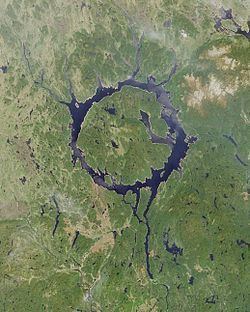Surface area 1,942 km (750 sq mi) Max. depth 350 m (1,150 ft) Surface elevation 359 m Mean depth 85 m Province Québec | Basin countries Canada Average depth 85 m (279 ft) Area 1,942 km² Catchment area 29,241 km² | |
 | ||
Lake type annular lake, reservoir, impact crater lake | ||
Manicouagan Reservoir (also Lake Manicouagan) is believed to have been caused by the impact of a meteor of 5 kilometres diameter, producing the annular lake (ringlike lake) in central Quebec, Canada. The lake covers an area of 1,942 km², and its eastern shore is accessible via Route 389. The lake island in the centre of the lake is known as René-Levasseur Island, and its highest point is Mount Babel. The lake and island are clearly seen from space and are sometimes called the "eye of Quebec." With a volume of 139.8 cubic kilometres (33.5 cu mi), the reservoir itself is the fifth largest in the world by volume, although only 35.2 cubic kilometres (8.4 cu mi) can be used for hydro-electric power production. In 2007, astronaut Marc Garneau nominated the reservoir for the CBC's Seven Wonders of Canada competition.
Contents
- Map of Manicouagan Reservoir RiviC3A8re aux Outardes QC Canada
- Manicouagan impact crater
- Hydroelectric project
- References
Map of Manicouagan Reservoir, Rivi%C3%A8re-aux-Outardes, QC, Canada
Manicouagan impact crater
Manicouagan Reservoir lies within the remnant of an ancient eroded impact crater (astrobleme). The crater was formed following the impact of an asteroid with a diameter of 5 kilometres (3.1 mi), which excavated a crater originally about 100 km (62 mi) wide, although erosion and deposition of sediments have since reduced the visible diameter to about 72 km (45 mi). It is the sixth-largest confirmed impact crater known on earth. Mount Babel is interpreted as the central peak of the crater, formed by post-impact uplift.
Research has shown that impact melt within the crater has an age of 214±1 million years. As this is 12±2 million years before the end of the Triassic, the impact that produced the crater cannot have been the cause of the Triassic–Jurassic extinction event.
Hydroelectric project
The lake was enlarged by flooding the earlier Lake Mouchalagane and Manicouagan by construction of the Daniel-Johnson Dam, part of the massive Manicouagan or Manic series of hydroelectric projects undertaken by Hydro-Québec, the provincial electrical utility, during the 1960s. The complex of dams is also called the Manic-Outardes Project because the rivers involved are the Manicouagan and the Outardes.
The Manicouagan Reservoir acts as a giant headpond for the Manicouagan River, feeding the Manic-2, Manic-3, and Manic-5 generating stations downstream. In the peak period of the winter cold, the lake surface is usually lower, since the turbines run all the time at peak load to meet the massive electrical heating needs of the province. The surface of the lake also experiences low levels in the extreme periods of heat in New England during the summer, since in that period Hydro-Québec sells electrical energy to the joint New England grid and individual utilities in the United States.
